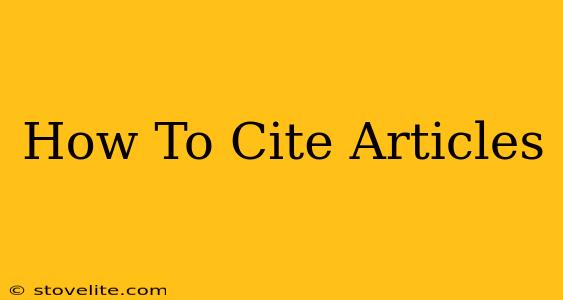Properly citing articles is crucial for academic integrity and avoiding plagiarism. Whether you're writing a research paper, essay, or even a blog post, understanding how to cite sources correctly is essential. This guide will walk you through the basics of article citation, focusing on the most commonly used styles: MLA, APA, and Chicago.
Understanding Citation Styles
Different academic disciplines and publications favor different citation styles. Each style has its own specific rules for formatting citations, both within the text (in-text citations) and at the end of your work (works cited or references page). Let's break down the three most prevalent styles:
MLA (Modern Language Association) Style
MLA is commonly used in the humanities, such as literature, languages, and cultural studies. It emphasizes brevity and clarity. Key features of MLA citation include:
- In-text citations: These typically include the author's last name and page number in parentheses. For example: (Smith 123). If the author's name is already mentioned in the sentence, only the page number is needed.
- Works Cited page: This page lists all sources cited in alphabetical order by the author's last name. Entries follow a specific format, including author, title, publication information, and more.
APA (American Psychological Association) Style
APA style is predominantly used in the social sciences, including psychology, sociology, and education. It focuses on providing detailed source information to ensure reproducibility and clarity. Key aspects of APA citation are:
- In-text citations: These usually include the author's last name and year of publication. For example: (Smith, 2023). If directly quoting, page numbers are also included.
- References page: This page lists all cited sources in alphabetical order by the first author's last name. Each entry includes a specific set of information, including author names, publication date, title, journal name (if applicable), volume, issue, and page numbers.
Chicago Style
Chicago style is frequently used in history, the arts, and some social sciences. It offers two main citation systems: notes and bibliography, and author-date. Key elements of Chicago style include:
- Notes and Bibliography: This system uses footnotes or endnotes for in-text citations and a bibliography at the end. Footnotes provide detailed source information.
- Author-date: This system is similar to APA, utilizing in-text author-date citations and a bibliography at the end.
How to Cite Different Types of Articles
The specific details of your citation will vary depending on the type of article you're citing. Here are some common examples:
Citing Journal Articles
Journal articles are a common source in academic writing. Regardless of the citation style, you will need information such as the author(s), article title, journal title, volume, issue, pages, and publication date.
Citing Magazine Articles
Magazine articles are cited similarly to journal articles, but instead of volume and issue numbers, you might include the month and day of publication.
Citing Online Articles
Citing online articles often requires additional information, such as the URL and the date you accessed the article. Be sure to include a stable URL, if possible, to avoid broken links.
Citing Newspaper Articles
Newspaper articles should include the author, article title, newspaper name, publication date, and section (if applicable).
Tips for Effective Citation
- Accuracy is paramount: Double-check all information to ensure accuracy.
- Consistency is key: Maintain a consistent citation style throughout your work.
- Use citation management tools: Tools like Zotero or Mendeley can streamline the citation process.
- Consult style guides: Refer to official style guides for the most up-to-date information.
Mastering article citation is a fundamental skill for any student or researcher. By understanding the basics of MLA, APA, and Chicago styles and following these tips, you can confidently cite your sources and avoid plagiarism. Remember to always consult the most current style guides for the most accurate and up-to-date information. Good luck!

